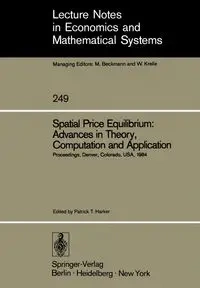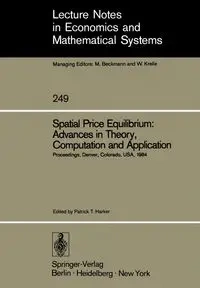Spatial Price Equilibrium - Harker Patrick T.
Spatial Price Equilibrium - Harker Patrick T.
- Advances in Theory, Computation and Application : Papers Presented at the Thirty-First North American Regional Science Association Meeting Held at Denver, Colorado, USA November 1984
EAN: 9783540156819
Marka
Symbol
170HJK03527KS
Rok wydania
1985
Strony
292
Oprawa
Miekka
Format
17.0x24.4cm
Redakcja
Harker Patrick T.
Język
angielski

Bez ryzyka
14 dni na łatwy zwrot

Szeroki asortyment
ponad milion pozycji

Niskie ceny i rabaty
nawet do 50% każdego dnia
Niepotwierdzona zakupem
Ocena: /5
Marka
Symbol
170HJK03527KS
Kod producenta
9783540156819
Rok wydania
1985
Strony
292
Oprawa
Miekka
Format
17.0x24.4cm
Redakcja
Harker Patrick T.
Język
angielski

The problem of predicting interregional commodity movements and the regional prices of these commodities has intrigued economists, geographers and operations researchers for years. In 1838, A. A. Cournot (1838)
discussed the equilibrium of trade between New York and Paris and noted how the equilibrium prices depended upon the transport costs. Enke (1951) recognized that this problem of predicting interregional flows and regional
prices could be formulated as a network problem, and in 1952, . Paul Samuelson (1952) used the then recent advances in mathe matical programming to formalize the spatial price equilibrium problem as a nonlinear optimization
problem. From this formula tion, Takayama and Judge (1964) derived their quadratic program ming representation of the spatial price equilibrium problem, which they and other scholars then applied to a wide variety of problem
contexts. Since these early beginnings, the spatial price equilibrium problem has been widely studied, extended and applied; the paper by Harker (1985) reviews many of these results. In recent years, there has been a growing
interest in this problem, as evidenced by the numerous publications listed in Harker (1985). The reasons for this renewed interest are many. First, new applications of this concept have arisen which challenge the theoretical
underpinnings of this model. The spatial price equilibrium concept is founded on the assumption of perfect or pure competition. The applications to energy markets, steel markets, etc. have led scholars to rethink the basic
structure of this model.
EAN: 9783540156819
EAN: 9783540156819
Niepotwierdzona zakupem
Ocena: /5
Zapytaj o produkt
Niepotwierdzona zakupem
Ocena: /5
Napisz swoją opinię

